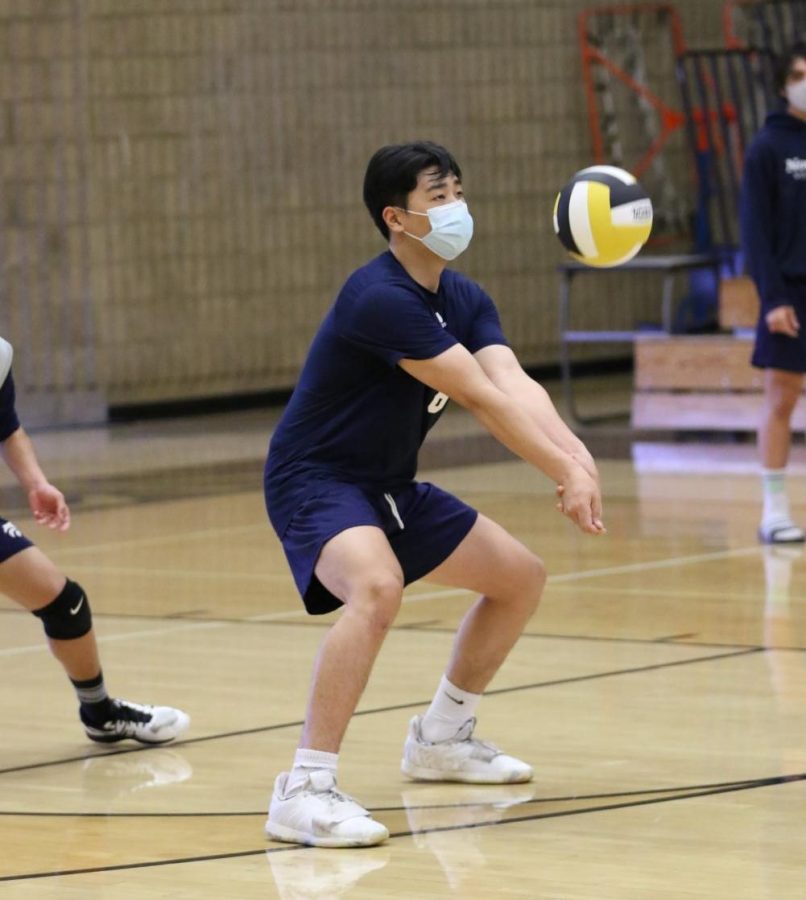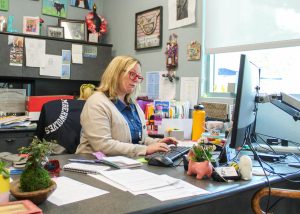CIF regulations spark controversy
DEFENDING SKILLFULLY: Junior Harry Kim swiftly receives a serve.
April 23, 2021
A San Diego lawsuit against Gov. Gavin Newsom and the state successfully altered public health and CIF regulations, allowing youth and adult sports, including indoor sports, to resume practice and competition if testing protocols and safety measures are administered. This change, which reinstated all sports at Northwood, is the latest move in an ongoing saga regarding a return to high school athletics, a heated topic since the start of the pandemic last year.
Enormous pressure on the state preceded these decisions. At the start of the year, Brad Hensley, the father of a football player at Mission Hills High School, co-founded a Facebook group called Let Them Play CA, which grew to over 60,000 members advocating for a return to normalcy in youth sports. In January and February, rallies at the state Capitol and high schools across the state—including Orange County—called for the loosening of COVID-19 restrictions, fueling the Recall Newsom campaign and contributing to its fulfilment of the 1.5 million signature threshold to qualify for the ballot.
“Forty of the other states across the country have successfully and safely done youth sports,” Hensley said to ABC 10News San Diego. “Approximately 30 million interactions and not one serious case of a hospitalization or serious illness from youth sports.”
The lawsuit that became a major win for “Let Them Play” activists was filed in the San Diego Superior Court on Jan. 28 on behalf of Nicholas Gardinera, a senior at Scripps Ranch High School, and Cameron Woolsey, a senior at Mission Hills High School. It echoed student-athlete and parent concerns for the negative mental health consequences, unfairness of professional and college athletes continuing their sports, other states safely conducting sports, data pointing to high school sports not being superspreaders of COVID-19 and athletic scholarships which more than 180,000 students yearly rely on to finance their education, now at risk.
San Diego Superior Court Judge Earl H. Maas III’s ordered that youth sports could resume if teams abide by the COVID-19 protocols of professional sports. This settlement scored a victory for athletes on high school and recreational teams alike.
For this year, CIF Southern Section condensed the three traditional sports seasons into two shortened and overlapping seasons. The Southern Section Championships will not be conducted for Season 1 and is still to be determined for Season 2.
“With the past year being so isolated, sports have really helped foster a better sense of community for me and reignite connections with my teammates,” Varsity Boys Volleyball player junior Logan Hardison said. “In terms of safety, I feel like the school is doing the best it can right now. The weekly COVID-19 tests for gym sports and the reinforcement of social distancing is allowing for a much safer environment.”
Currently, indoor and outdoor sports have returned to practices and competitions this season with reopening guidelines, including weekly COVID-19 tests for indoor sports, wearing face coverings at all times (with certain exceptions), limiting observers at competitions and practices, maintaining the “maximum extent possible” between participants and completing a self-assessment for COVID-19 symptoms. In compensation for restricting observers, video streaming of competitions are provided.
However, the “maximum extent possible” can be no distance at all in high-contact sports, and self-assessments for COVID-19 may not be enough. It is also worth noting that sports thus far have had an unnoticable impact on COVID-19 cases, regardless of their inability to guarantee student safety from exposure. Findings from the UW School of Medicine and Public Health last October suggest that “participation in sports isn’t associated with an increased risk of COVID-19 among athletes but call for expanded studies to build a more complete picture.” It’s a risk, but for many, it’s a risk worth taking.



![AAAAAND ANOTHER THING: [CENSORED] [REDACTED] [BABY SCREAMING] [SIRENS] [SILENCE].](https://thehowleronline.org/wp-content/uploads/2025/06/lucy-1200x800.jpg)






















































![AAAAAND ANOTHER THING: [CENSORED] [REDACTED] [BABY SCREAMING] [SIRENS] [SILENCE].](https://thehowleronline.org/wp-content/uploads/2025/06/lucy-300x200.jpg)